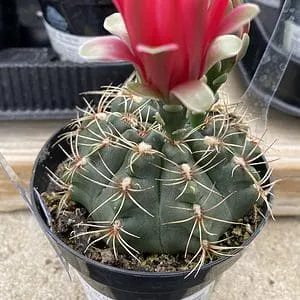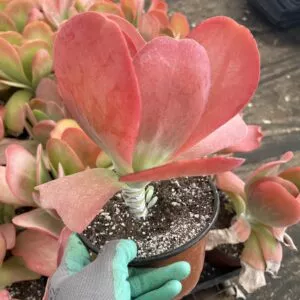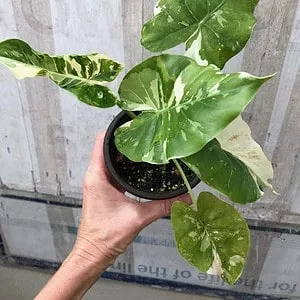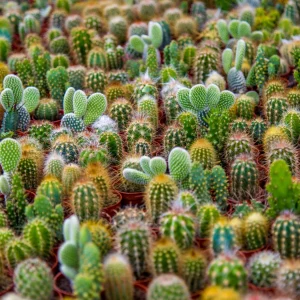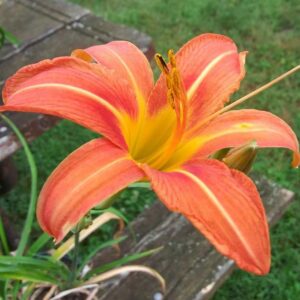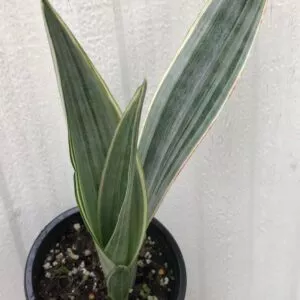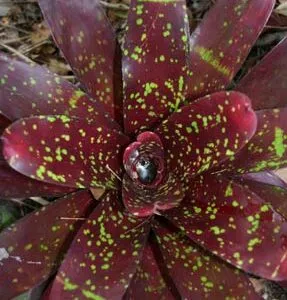No products in the cart.
Table of Contents
If you’re looking for an easy-to-grow indoor plant that you can either have as an accent or a decorative houseplant to sit on that kitchen countertop or coffee table, Moses-in-the-cradle is a gorgeous specimen to start with.
What Is a Moses-in-the-Cradle Plant?
Moses -in-the-cradle (Tradescantia spathacea) is becoming popular among ornamental plants. They are usually grown in a decorative container where they can easily flaunt their dark-green lance-shaped leaves that are oftentimes purple underneath.
The plant is also characterized by its small, white, three petalled flowers that open out of the purple boat or cradle-shaped bracts. Moses-in-the-cradle plants can self-pollinate and have a clumping habit.
These perennial plants are native to southern Mexico, and Central America. They’re quite small and only grow approximately 30 cm (11.8 inches). Moses-in-the-cradle’s scientific name was originally recorded as Rhoeo discolour, then it was later on changed to Tradescantia spathacea. The plant is also often referred to as Moses in a Boat, Moses in a basket, Cradle Lily, and Boat Lily.
Moses-in-the-Cradle Care

Tradescantia species are known not only for their stunning foliages but also for their low maintenance quality. But if you wish to know more about Moses-in-the-cradle plant care, have a go on this guide. For nothing beats a well-informed plant parent!
The Right Potting Mix
Moses-in-the-cradle generally prefers good-quality, all-purpose potting soil. Ideally, a well-draining loose soil that can retain moisture is what you’re after. This is achieved through a fair mixture of peat moss and some other organic matter.

You want to have soil that prevents the roots from staying wet too long which causes root rot. When considering repotting the Moses-in-the-Cradle plant, be sure that the roots have filled the existing pot first. This will prevent unnecessary root disturbance.
Once a month, you may apply a balanced houseplant fertilizer that contains the essential nutrients needed for a healthy plant.
Moses-in-the-Cradle Plant Light Requirements

Have your plant placed under a bright, indirect light for good foliage color and flowers. Most Tradescantia species like a very bright light with which they need to be exposed at least 6-8 hours a day.
They can also be low-light tolerant (partial shade), however, this will make the leaves appear more green than purple. Avoid direct sunlight as this can cause the foliages to scorch.
In stock In stock In stock Only 1 left in stock
Free Shipping
$37.95 – $42.95
Sold By:
A&K Plants
Philodendron ‘Velvet’ – Rare Houseplant | Easy Care | Free Shipping | 4-inch pot
Only 22 available and it’s in 2 people’s basket Rated 4.95 out of 5 based on 66 customer ratings00
Sold By:
A&K Plants
$12.99
Sold By:
Succulent Oasis
Cactus Plant Medium Chin Cactus
Rated 4.84 out of 5 based on 352 customer ratings00
Sold By:
Succulent Oasis
$25.99
Sold By:
Cacti and Exotica
Kalanchoe | Paddle Plant | Flapjack
Only 9 available and it’s in 1 people’s basket Rated 4.98 out of 5 based on 59 customer ratings00
Sold By:
Cacti and Exotica
Free Shipping
$10.00
Sold By:
Bay Urban Habitat
Jelly bean sedum 1 inch cutting
Sold By:
Bay Urban Habitat
Watering Needs When Caring for Tradescantia Spathacea
Moses-in-the-cradle plants are not a fan of overwatering, in fact, too much moisture retained in the soil can lead to one of the many houseplant long-standing nemeses: root rot.

Cradle Moses likes their soil moist during spring and fall. Yet in cold temperatures, such as during winter, the plant needs to dry out slightly in between watering cycles.
For potted plants, be sure to use a container with drainage holes. This will prevent water from becoming stagnant.
Temperature and Humidity

Moses-in-the-cradle plant has been naturalized outdoors and is said to be hardy to USDA Zone 9 and higher. But they are most preferred indoors as they may become invasive.
The ideal temperature for tradescantia plants is 60-85 °F (16-19 °C). The cooler ambient temperature at night may also be beneficial.
A high humidity level should also be maintained for your Moses plant. You can easily maintain this at home by regularly misting the leaves using a spray bottle with distilled or filtered water. If treated as an outdoor plant, you may opt to use the pebble tray technique, wherein you fill up a tray with ornamental stones and water, then place it under the plant pot.
Humidity levels are an important aspect of caring for your Moses-in-the-cradle plants, especially for temperate climates which tend to have dry air. By maintaining the humidity of at least 40 – 50 %, you can prevent discolored foliage and stunted growth.
In stock In stock In stock In stock
$55.95
Sold By:
SunSoul Plants
$97.00Alocasia Odora ‘Variegata’ plant ‘Okinawa Silver’ in 3″ pot
Only 1 available and it’s in 2 people’s basket Rated 4.87 out of 5 based on 98 customer ratings00
Sold By:
SunSoul Plants
$40.00
Sold By:
NEEPA HUT
6″ Lipstick black pagoda + Striped Noir Planter Basket
Only 3 available and it’s in 3 people’s basket Rated 4.99 out of 5 based on 221 customer ratings10
Sold By:
NEEPA HUT
Free Shipping
$8.96
Sold By:
CZ Grain
Cacti Seeds Mix – 50 Seeds – Cactus Species Mix – Ships from Iowa, USA – Grow Exotic Succulent Cacti
Only 900 available and it’s in 2 people’s basket Rated 4.60 out of 5 based on 156 customer ratings00
Sold By:
CZ Grain
$11.00
Sold By:
Cindi's Playground
Orange Daylily Ditch Lily
Only 2 available and it’s in 3 people’s basket Rated 5.00 out of 5 based on 19 customer ratings04
Sold By:
Cindi's Playground
How to Propagate Tradescantia Spathacea
Stem cuttings are the easiest way to propagate Moses-in the-cradle-plant aside from division. Take some of the stem cuttings by using a sharp, sterilized blade in between growth nodes.

Once you’ve attained the propagules, you can either root the stem cuttings directly in water or plant them on well-maintained fresh potting soil.
Be sure that no indirect light is hitting the pot with your newly planted cuttings. In just a few weeks, you’ll be able to observe some roots developing. Transfer your tradescantia spathacea plants to a container of your choice filled with well-draining soil.
Moses-in-the-Cradle Varieties
Rhoeo discolor ‘Variegata’

Rhoeo discolor tricolor (Tradescantia spathacea) is a perennial evergreen succulent recognized for its three-toned leaves having pink, green, and cream shades, as well as pinkish-purple undersides. They are considered an easy houseplant to grow and are quite suitable to warm room temperatures. Rhoeo discolor tricolor is drought-tolerant and is perfect in pots or hanging baskets.
Tradescantia fluminensis

Tradescantia fluminensis ‘Wandering Jew‘ comes from the family of spiderwort and flaunts foliage with a vigorous trailing structure. An average indoor temperature of at least 65-75ºF will work just fine, but should not be lower than 50 ºF. They are great for container edges or in a hanging basket.
Creeping Inch Plant

Creeping Inch plant (Callisia repens), also known as Bolivian Jew or turtle vine, is a succulent creeping plant from the plant family, Commelinaceae. A soil moist and partial shade is most preferrable but the plant can also thrive in full sun.
In stock In stock In stock Only 1 left in stock
Free Shipping
$37.95 – $42.95
Sold By:
A&K Plants
Philodendron ‘Velvet’ – Rare Houseplant | Easy Care | Free Shipping | 4-inch pot
Only 22 available and it’s in 2 people’s basket Rated 4.95 out of 5 based on 66 customer ratings00
Sold By:
A&K Plants
$12.99
Sold By:
Succulent Oasis
Cactus Plant Medium Chin Cactus
Rated 4.84 out of 5 based on 352 customer ratings00
Sold By:
Succulent Oasis
$25.99
Sold By:
Cacti and Exotica
Kalanchoe | Paddle Plant | Flapjack
Only 9 available and it’s in 1 people’s basket Rated 4.98 out of 5 based on 59 customer ratings00
Sold By:
Cacti and Exotica
Free Shipping
$10.00
Sold By:
Bay Urban Habitat
Jelly bean sedum 1 inch cutting
Sold By:
Bay Urban Habitat
Dealing with Moses-in-the-Cradle Diseases and Pests
Spider mites and Mealy Bugs are two of the most common insect pests that may pose damage to your houseplants such as the moses-in-the-cradle plant. However, you can control their infestation by manually picking off the insects and their egg sacs and by simply dabbing with alcohol-soaked cotton swabs or use of a more natural pesticide such as neem oil.
Meanwhile, some of the most prevalent diseases of cradle plants are often attributed to improper cultural practices. For example, overwatering, inadequate soil moisture levels, uncontrolled humidity, and even too much fertilizer. Such conditions often lead to stunted growth, dead or decaying roots, and brown leaf tips.
If any of these symptoms appear, remove the infected or diseased portion of the plant, observe proper watering as described above, and avoid using cheap fertilizer which can lead to toxic reactions due to salt accumulations.
Frequently Asked Questions
Moses-in-the-cradle can either be grown as indoor plants or outside as border plants or in hanging baskets.
Your Moses-in-the-cradle plant should not be left sitting under direct light. Such intensity causes the foliage to fade from its naturally vibrant pattern. Note that an indirect bright light favors not only a good coloration but as well as optimum growth.
To keep them looking full and bushy, regularly prune your Moses-in-the-cradle plants, particularly during spring.
Now that you’ve figured out how you can easily grow Moses-in-the-cradle plant, be sure to purchase on a reliable shop such as Plantly!
Whether you want to buy, sell or simply reach out to other plant enthusiasts, Plantly is the right place to be!
-
$15.95Sold By: SunSoul Plants
$20.95In stock
Sansevieria Bantel’s Sensation in 4″ pot, ships in pot
Only 1 available and it’s in 1 people’s basketRated 4.87 out of 5 based on 98 customer ratings01Sold By: SunSoul Plants -
$13.99Sold By: BubbleBlooms
In stock
Variegated Hoya Kerrii Heart / Sweetheart Plant / Mothers day plant / Hoya Plant / Heart Shaped Succulent / Heart Hoya / Live Plant Rare
Rated 4.81 out of 5 based on 279 customer ratings01Sold By: BubbleBlooms -
$12.99Sold By: BubbleBlooms
In stock
Silver Squill Leopard Plant, Ledebouria socialis, 4 inch
Rated 4.81 out of 5 based on 279 customer ratings00Sold By: BubbleBlooms -
Free Shipping$21.99Sold By: Gar-Zen Botanical Design
In stock (can be backordered)
Bromeliad Jack of Diamonds Neoregelia Ships Free
Only 9 available and it’s in 1 people’s basketRated 4.86 out of 5 based on 49 customer ratings00Sold By: Gar-Zen Botanical Design

